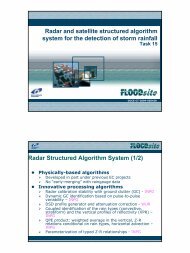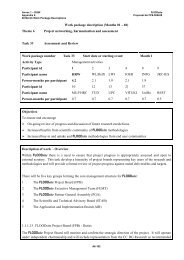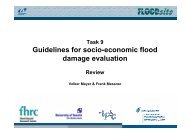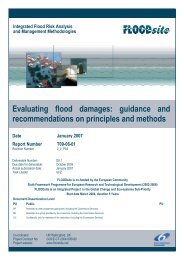Evacuation and traffic management (full report) - FLOODsite
Evacuation and traffic management (full report) - FLOODsite
Evacuation and traffic management (full report) - FLOODsite
Create successful ePaper yourself
Turn your PDF publications into a flip-book with our unique Google optimized e-Paper software.
Task 17 <strong>Evacuation</strong> D17-1<br />
Contract No:GOCE-CT-2004-505420<br />
2. Review of flood event <strong>management</strong> practice<br />
2.1 Introduction<br />
This chapter provides a review of flood event <strong>management</strong> in a number of countries in Europe<br />
including:<br />
• The UK;<br />
• The Netherl<strong>and</strong>s;<br />
• Germany;<br />
• France;<br />
• Hungary;<br />
• General overview of Europe.<br />
This review covers the legal framework <strong>and</strong> institutional set ups in these countries <strong>and</strong> their<br />
experience with operational flood <strong>management</strong>. This chapter focuses particularly on the <strong>management</strong><br />
of flood emergencies, <strong>and</strong> evacuation <strong>and</strong> rescue methods <strong>and</strong> models.<br />
2.2 The United Kingdom<br />
2.2.1 The legal framework for flood <strong>management</strong> <strong>and</strong> emergencies<br />
Background<br />
The main piece of legislation covering emergency <strong>management</strong> in the UK is the Civil Contingencies<br />
Act. This legislation <strong>and</strong> accompanying non-statutory measures give a single framework for civil<br />
protection in the UK. This objective of the Civil Contingencies Act is to improve the UK's ability to<br />
deal with the consequences of major disruptive incidents by improving the planning process at a local<br />
level, building better contacts between agencies <strong>and</strong> improving the link between local areas <strong>and</strong><br />
central government.<br />
Civil Contingencies Act (CCA)<br />
The Civil Contingencies Act (CCA) <strong>and</strong> accompanying non-legislative measures <strong>and</strong> Regulations<br />
deliver a single integrated framework for civil protection. The Act applies to the whole of the UK,<br />
including devolved administrations <strong>and</strong> came into force in 2004. “Emergency” is defined under the<br />
Act as “an event or situation which threatens serious damage to human welfare in a place in the UK,<br />
the environment of a place in the UK, or war or terrorism which threatens serious damage to the<br />
security of the UK” (HM Government, 2005a). Part 1 of the Act establishes a new statutory<br />
framework for civil protection at the local level. Part 2 repeals existing emergency powers legislation<br />
<strong>and</strong> allows the development of special temporary legislation aimed at providing the powers required to<br />
deal with a serious emergency ” (HM Government, 2005a).<br />
The Act provides a basic framework defining what tasks should be performed during an emergency,<br />
<strong>and</strong> how co-operation should be conducted. Working to a common framework, local responders are<br />
required to make their own decisions in the light of local circumstances <strong>and</strong> priorities about what<br />
planning arrangements are appropriate in their area. The CCA recommends an Integrated Emergency<br />
Management (IEM) procedure that comprises six related activities:<br />
• Anticipation;<br />
• Assessment;<br />
• Prevention;<br />
• Preparation;<br />
• Response;<br />
• Recovery.<br />
T17_07_02_<strong>Evacuation</strong>_<strong>and</strong>_<strong>traffic</strong>_<strong>management</strong>_D17_1_V4_4_P01.doc 19 03 2008<br />
8











